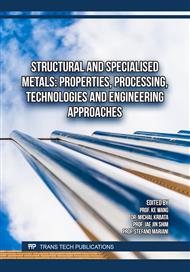p.49
p.63
p.69
p.75
p.91
p.97
p.103
p.109
p.117
Preparation of a Graphene Oxide/Cellulose Thermal Conductive Adhesive and its Application on Cut Tobacco
Abstract:
The absence of materials with excellent thermal conductivity inside the heat not burning tobacco affects the smoking taste, so the exploration of high thermal conductivity materials has attracted much attention. Graphene oxide (GO) is widely used as a functional material due to its high thermal conductivity, but there are some risks associated with its application in food. Through the esterification reaction between cellulose (soluble and edible) and GO, the covalent bond fixation of graphene thermal conductive material was realized, and the functional cellulose material with high thermal conductivity was formed in the study. The coupling form, mechanical property stability, microstructure and thermal conductivity were characterized by FTIR, DSC and SEM, and the results showed that the carbonyl peak of graphene in the thermal conductive adhesive was transferred from 1651 cm-1 to 1716 cm-1, indicating that graphene was successfully attached to cellulose through ester bond. Furthermore, the decomposition temperature of the thermal conductive adhesive is about 300 °C, which meets the requirements for stability, and the addition of the thermal conductive adhesive does not change the apparent structure of cut tobacco. The thermal conductivity coefficient of the reinforced thermal conductive tobacco obtained in this study is between 0.5-1.4 Wm-1K-1 (without thermal conductive adhesive: 0.135 Wm-1K-1), which meets the actual thermal conductivity requirements. The thermal conductive adhesive material has good adhesion with tobacco flakes, and is easy to dry, which also simultaneously can block the migration risk of graphene material to human body during tobacco smoking. This work provides a certain reference for the development of graphene reinforced thermal conductive adhesive in the field of new tobacco.
Info:
Periodical:
Pages:
91-96
Citation:
Online since:
June 2025
Authors:
Price:
Сopyright:
© 2025 Trans Tech Publications Ltd. All Rights Reserved
Share:
Citation:



